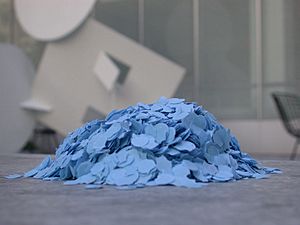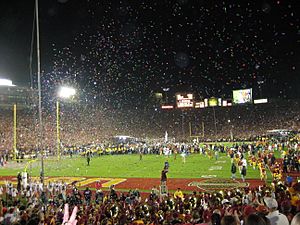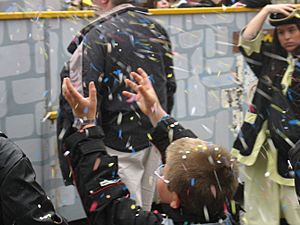Confetti facts for kids
Confetti are tiny pieces of paper, plastic, or shiny metallic material. People usually throw them during happy events like parades, when sports teams win, or at celebrations. Weddings and game shows often use confetti too!
The word "confetti" comes from the Latin word confectum. It's the plural of the Italian word confetto, which means "small sweet." Long ago, people threw grains and sweets during special occasions. Over time, this tradition changed, and people started throwing paper confetti instead.
Confetti comes in many colors and shapes. You can find them shaped like stars, circles, or even snowflakes during winter. There's a difference between confetti and glitter. Glitter is much smaller, usually less than 1 millimeter, and always shiny. Most table confetti is also shiny. What we call "metallic confetti" is actually made from shiny plastic called metallized PVC.
You can find paper and metallic confetti at most party supply stores. Confetti is popular at parties, weddings, and Bar Mitzvahs. Simple confetti can even be made from shredded paper, like the kind used in ticker-tape parades. You can make small round pieces using a hole punch.
Confetti is often used at sports events when a team wins a trophy. For these big events, they use larger strips of paper, usually about 20 mm by 60 mm. These strips are often in the winning team's colors. For smaller amounts, confetti is shot out of "cannons" using compressed air or carbon dioxide. For bigger places, special air movers powered by carbon dioxide can shoot huge amounts of confetti much farther.
Contents
History of Confetti
Since the Middle Ages, people in Northern Italy threw things during carnival parades. They often threw mud balls, eggs, coins, or fruit. Some towns still have similar traditions today, like the "Battle of the Oranges" in Ivrea.
Throwing objects at parades has been happening in Milan since the 1300s. Rich people would throw candies and flowers. Ladies would throw eggshells filled with perfumes. Poorer people would throw rotten eggs to make fun of the rich. Sometimes, battles even broke out between different groups.
In 1597, the city governor, Juan Fernández de Velasco, banned throwing eggs. He also banned other messy behaviors. The custom stopped for about 100 years. It came back in the 1700s, with people throwing small candies, like sugar-coated seeds. The seeds were often from coriander plants, which grew in the area. This is why the Italian word for paper confetti is coriandoli.
These candies were expensive. So, poorer people often used small chalk balls instead. These were called benis de gess (chalk candy). In 1808, the Prefect of Milan said these chalk balls were the only things allowed to be thrown. But the chalk battles in the 1800s became too big and dangerous. Hundreds of people were involved, so the chalk pellets were banned. People then started using mud balls instead.
In 1875, a businessman from Milan, Italy, named Enrico Mangili, started selling paper confetti. He sold it for the yearly carnevale di Milano parade.
At that time, Milan was a big center for making silk. Mangili started collecting the small paper disks left over from making holed sheets. These sheets were used by silkworm breeders. He sold these paper disks for profit. People loved the new paper confetti because it was less harmful, more fun, and cheaper. Its use quickly spread in Milan and northern Italy.
The magazine Scientific American reported that paper confetti was thrown at New Year's Eve in Paris in 1885. Paper confetti became common all over Europe within a few decades.
Confetti Alternatives
At weddings, a new trend is to use natural petal confetti. These are made from freeze-dried flower petals. They are completely safe for the environment and break down naturally. Many wedding places now only allow these biodegradable versions.
Some wedding venues have even banned confetti completely because it can make a mess. To get around this rule, some people use soap bubbles instead of confetti.
Etymology and Italian Confetti
The English word confetti (meaning the small paper pieces) is linked to an Italian sweet with the same name. This sweet, also called dragée, is an almond covered in a hard sugar coating. It was traditionally thrown during carnivals. The Italian word confetti can be translated to mean confit, like in "confiture" (jam). The Italian word for paper confetti is coriandoli, which refers to the coriander seeds that were originally inside the sweet.
In Italy, these sugar-coated almonds (Italian confetti) are given out at weddings and baptisms. They usually have a white coating for these events. For graduations, they have a red coating. They are often wrapped in a small tulle bag as a gift for guests. At weddings, they are said to represent the hope that the new couple will have many children. In the UK, people started using colorful paper shreds at weddings instead of rice in the late 1800s.
Images for kids
See also
 In Spanish: Confeti para niños
In Spanish: Confeti para niños









